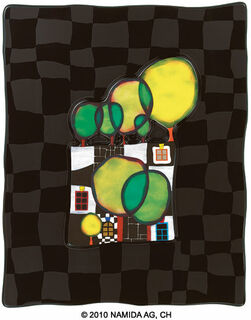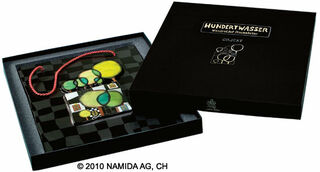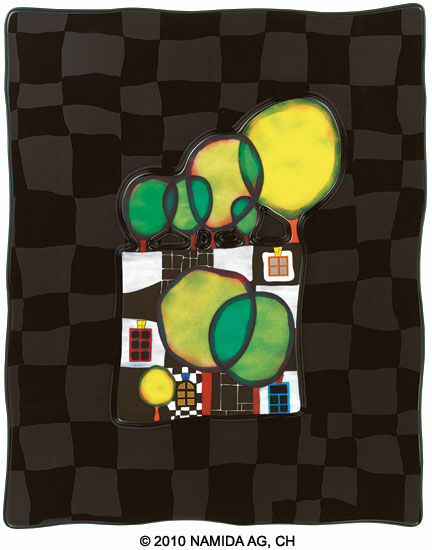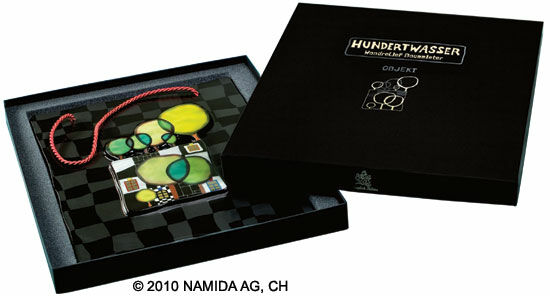(APA 378/XII) Wall relief "Tree Tenant"
(APA 378/XII) Wall relief "Tree Tenant"
Quick info
ars mundi Exclusive Edition | limited, 999 exemplars | numbered | porcelain | 13 colours | gold decoration | size 33 x 41 cm | hanging cords | noble cardboard box
Detailed description
(APA 378/XII) Wall relief "Tree Tenant"
The wall relief "Tree Tenant" is symbol for a life in harmony with nature.
Hundertwasser envisioned the tree tenant as a widely visible symbol of the reparation toward nature. Through the tree tenant, beauty and joy of life come back being in coexistence with nature. The tree tenant is a donor, a piece of nature, a piece of home, a piece of spontanious vegetation in the anonymous, sterile desert of the city.
In cooperation with the famous Königlich privilegierte Porzellanmanufaktur Tettau (royal privileged porcelain manufacturer Tettau) we achieved to create this exclusive Hundertwasser porcelain object. Already since 1794 the famous "T" from Bavaria has been attesting to experience, tradition and arts and crafts, that are known and appreciated by collectors and aficionados from all over the world. The high quality wall relief is trimmed with real gold and painted with 13 spot colors. Burned 3 times. Format 33 x 41 cm. Work number PM XI. Acc. to APA 378/IX. Strictly limited edition of 999 pieces, each numbered by hand. ars mundi exclusive-edition.
Supplies: The high quality wall relief will be delivered in an exclusively black card board with gold print and three different colored cords for an individual hanging.
Copyright NAMIDA AG, 2010.
The displayed works of art are protected under the copyright. In particular, it is not permitted to reproduce, to alter, to print or to publish these works of art. Violations will be prosecuted according to civil and criminal law.
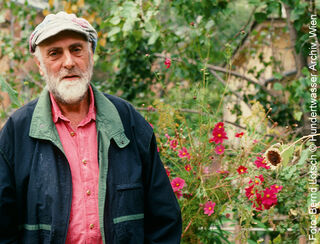
About Friedensreich Hundertwasser
1928-2000
Hundertwasser is one of the most internationally renowned artists of our time. His worldwide reputation was already established in the 1960s. Followed by an eventful and evocative career. His aura and power emerged from his painting and multifaceted work.
Organizing demonstrations, speeches, happenings and campaigns, addressing ecological issues, advocating a life in harmony with nature, manifestos for nature, standing up for a more humane architecture and the improvement of people's lives.
Hundertwasser originated projects such as the tree tenants, the roof afforestation, the regreening of cities, the humus toilet, the restoration of social values and the natural cycles. He was an admonisher against environmental pollution, against the dangers of nuclear energy, against natural degradation and the destruction of natural heritage, and in favour of a waste-free society.
Hundertwasser has been engaged with architecture since the 1950s. On the occasion of the inauguration of the Hundertwasser House of the City of Vienna (1986), he said: "We are again experiencing a turning point where old and rigid values in architecture and urban developement are increasingly being questioned. The straightness and uniformity of Bauhaus architecture is coming to an end because it is callous, sterile, cold, heartless, aggressive and emotionless. The era of absolute rationalism is coming to an end. The new values are enhanced quality of life, not standard of living. Longing for romance, individuality, creativity, especially creativity and living in harmony with nature."
With Friedensreich Hundertwasser, our epoch has found the most imposing challenger of totalitarian thinking, whether it concerns nuclear energy, genetic manipulation, environmental protection or the design of our living space. Hundertwasser lived completely in harmony with his view of things and opposing the contradictions of post-industrial society. Hundertwasser's significance is his art that produces beauty: a message of natural harmony, peace and joy.
Graphic or sculpture edition that was initiated by ars mundi and is available only at ars mundi or at distribution partners licensed by ars mundi.
Ceramic product made of kaolin, quartz and feldspar.
Porcelain is formed by turning or pressing and figurative objects are cast. Complex objects have to be cast in separated steps and sections and then "assembled". After the moulding, the pieces are dried and "annealed" at about 900 °C. Next, the glaze will be applied and fired at temperatures between 1,240 °C and 1,445 °C. In renowned manufactures, the porcelain is painted by hand whereby each colour has to be fired individually and in compliance with narrow temperature tolerances.
Porcelain was invented in China and became widespread in Europe from the 16th century onwards. The first European porcelain factory was founded in Meissen, Germany in 1710.
Other famous European porcelain factories include Fürstenberg, Höchst, Schwarzburger Werkstätten, Lladró, Nymphenburg, KPM, Augarten, Sèvres, Limoges, Royal Copenhagen, Worcester. Individual factories label their products with their personal porcelain stamps so that for the collecter it is easy to identify their origin.

